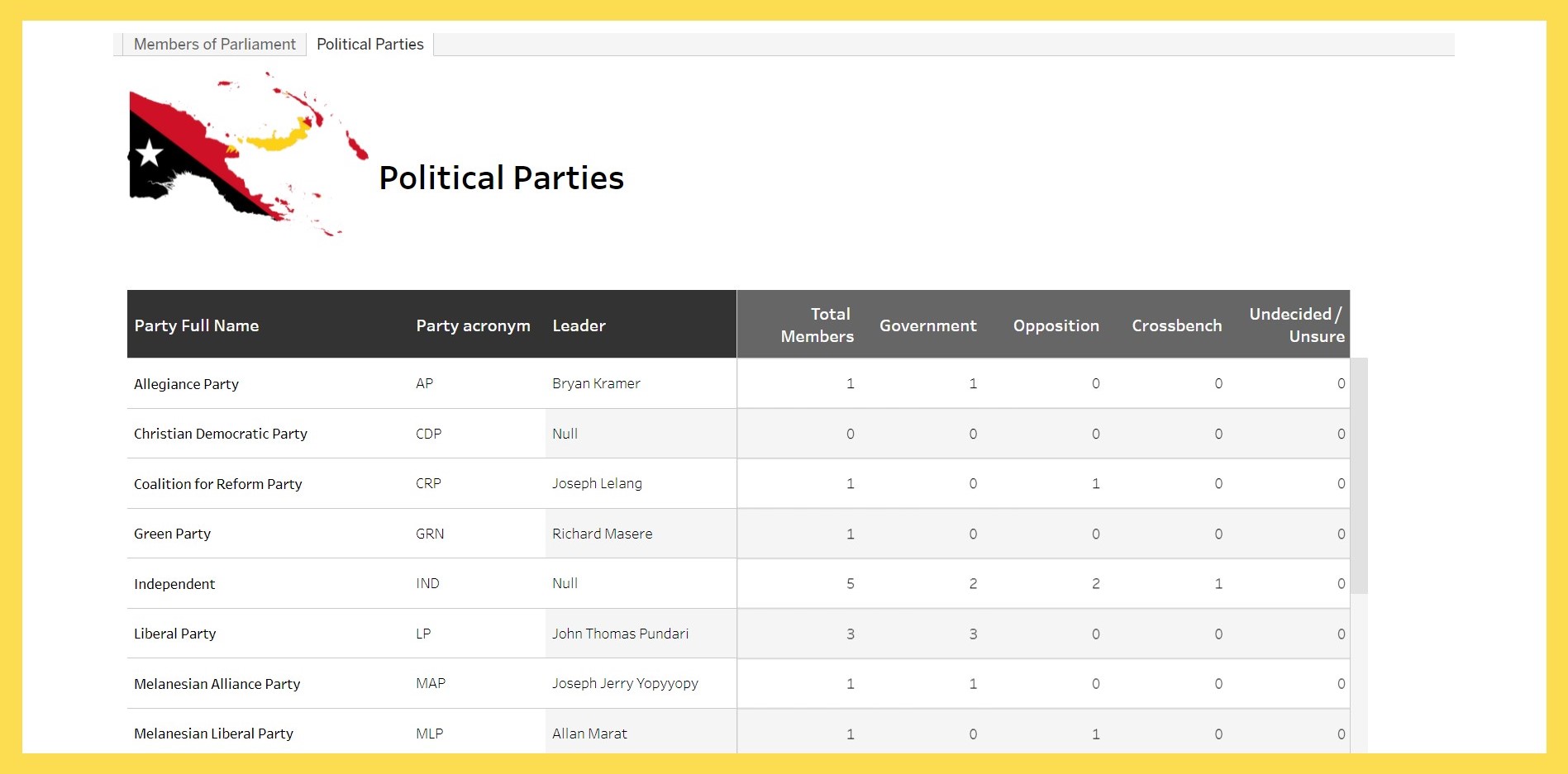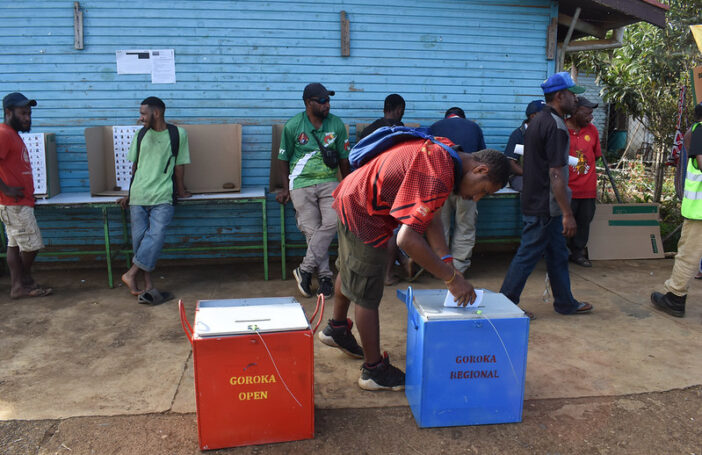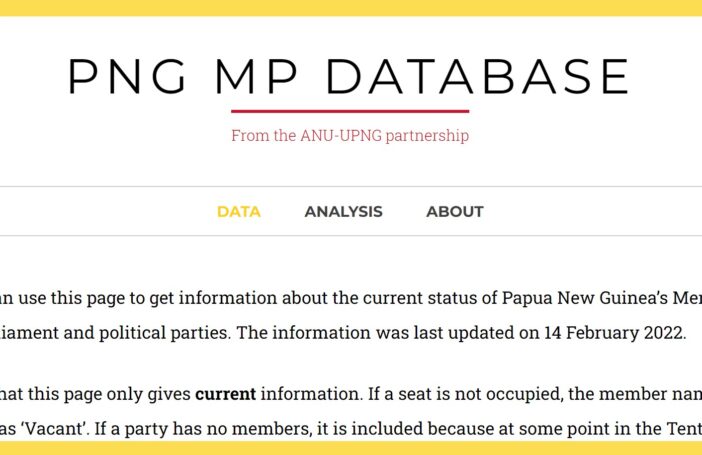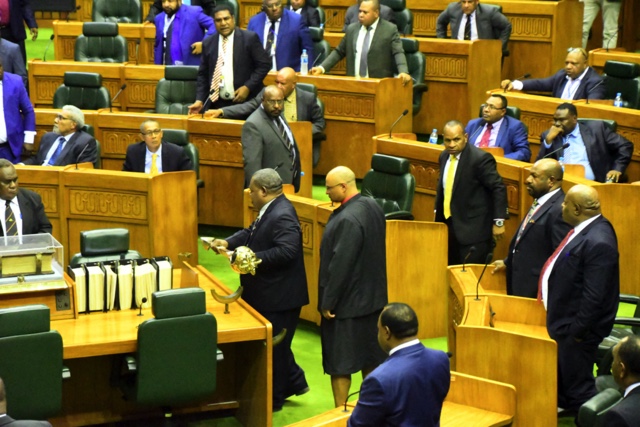Papua New Guinea (PNG) has many parties in parliament, which makes for both a fragmented parliament and a fragmented government. It is difficult, though, to measure fragmentation during a parliament term as data is scarce. This has changed recently with the launch of the PNG MP Database for PNG’s Tenth Parliament. In this post, I describe fragmentation in parliament, in government, and among ministers. I also discuss what to expect in parliament following this year’s election.
PNG has one of the most fragmented parliaments in the world. In a previous blog, I calculated parliamentary fragmentation using an index known as the effective number of parties (ENP). The ENP weights the number of parties according to total number of seats won, thus giving a higher weight to larger parties. Parliaments that are fragmented across many, small parties will have higher ENPs than parliaments with a few parties, or parliaments with many parties but which are dominated by a smaller subset.
Using the ENP, PNG’s parliament fragmentation after the 2017 elections was high: 6.9 if calculated with independents excluded, or 9.1 with independents included and treated as separate ‘parties’. This puts PNG among a very small group of countries globally with highly fragmented parliaments: Belgium (9.7), Bosnia and Herzegovina (8.7), Brazil (16.5), Indonesia (7.5) and the Netherlands (8.1). However, PNG’s ENP hasn’t stayed static throughout the political cycle of this parliament.
The number of parties in parliament began at 21 in 2017 and has grown since. The ENP, however, has fluctuated and is now actually lower than it was in 2017. (My calculations here and in the rest of this post are made including independents as if they were individual parties. Trends do not change much if independents are excluded.)
What is interesting about the chart below is that the ENP fluctuated, first as government was formed following the 2017 elections, and then around the two votes of no confidence (VoNC): the first, which saw James Marape replace Peter O’Neill as prime minister (PM), in May 2019; the second, an unsuccessful attempt against Marape in December 2020.
The ENP has fluctuated because many members of parliament (MPs) change parties during the turbulent times of government formation and VoNCs, with one blog noting that 76 MPs switched parties at least once since 2017. The ENP fell from 9.1 to 4.2 as O’Neill formed government in August 2017, his party, the People’s National Congress (PNC), growing in number from 29 to 48 MPs. The ENP increased to 7.29 during the first VoNC, then rose slightly to 7.34 during the second VoNC. The ENP increased again to 8.2 in 2021, reflecting the aftermath of the second VoNC, before falling to 7.1.

The PNG MP Database also, for the first time, enables fragmentation within government coalitions to be measured. The ENP includes MPs in government that belonged to parties split between government and opposition.
O’Neill formed government with an ENP of 3, reflecting a coalition including the three largest parties: the PNC (with 48 MPs), the Papua and Nuigini Union Pati (PANGU, with 13 MPs), and the United Resources Party (URP, with 11 MPs). The ENP then rose to 6.5 during the first VoNC when O’Neill was ousted by Marape, before falling to 3.5 during the second VoNC.
After the first VoNC, Marape’s PANGU party remained the largest, averaging 29.5 MPs till present. However, his government is more fragmented compared to O’Neill’s, thanks, in part, to the inclusion of several relatively large parties: the National Alliance, the URP, the United Labor Party, and the People’s Party. The government’s ENP rose to 5 in 2021 after Marape’s coalition survived the second VoNC, and has maintained that level till now.

A further measure of fragmentation of government coalitions that can be calculated is the policy coherence index (PCI). The PCI measures the amount of political influence that each coalition party wields, by calculating the probability that ministries are awarded to different parties. Ranging from 0 to 1, a PCI approaching 1 indicates that cabinet is more fragmented across parties.
As the chart below shows, the PCI and the number of parties that were awarded ministries trend together. In 2017, with less fragmentation within government (PCI = 0.48), O’Neill was able to appoint his cabinet from only five parties (despite having 14 parties in government). The PCI then increased to a high of 0.82 during the first VoNC, reflecting ministries awarded to 11 parties in Marape’s government. The PCI then fell to 0.76 as Marape warded off the second VoNC, reflecting eight parties awarded ministries in a cabinet reshuffle. Since February 2021, the PCI has been 0.77 with 11 parties awarded ministries.

Calculating the fragmentation of parliament and government is instructive, as PNG’s political history is replete with votes of no confidence. In the past, three PMs have been replaced by a VoNC (Somare in 1980, Somare in 1986, and Wingti in 1988), while three others have resigned to avoid a VoNC (Wingti in 1993, Skate in 1998, and O’Neill in 2019). During PNG’s Tenth Parliament, forming government after the election led to a less fragmented parliament and government; whereas both VoNCs led to greater fragmentation of parliament and government.
The 2022 elections will likely see many parties elected, making parliament highly fragmented once more. Government, when formed, is likely to be less fragmented as MPs switch parties to join the largest party. However, once the 18-month grace period ends, and another VoNC ensues, fragmentation within parliament and government may once again change.






Thanks Maholopa – the numbers are very instructive.
Is there now scope for a further examination of the consequent decision-making by the Government(s) of the day(s) please?
If Governments are regularly replaced by Votes of No Confidence or resign to avoid them, what does this mean for continuity in “government” (with a small “g”)?
Does this then disrupt the relationship(s) between Ministers and their Departments and thus the continuity in public administration and the effectiveness of that administration? Do programs as administered by PNG public servants retain their momentum?
Something that is part of the current debate in Australia about the long-term effectiveness of the Australian Public Service.
Thanks Peter.
From what I’ve seen, changes in government, and within government in terms of ministers brings about policy change, but not personnel change, except at the top i.e. heads of departments.
An example of change in policy when Marape came into power was the scrapping of the free health and education policy, and bringing in the IMF for a staff monitored program in 2020.
An example of change in policy was the review of the Department of Justice and Attorney General’s office, once Brian Kramer was given the ministry.
PNG’s fluid political scene makes it very difficult to follow its long term plans such as Vision 2050.